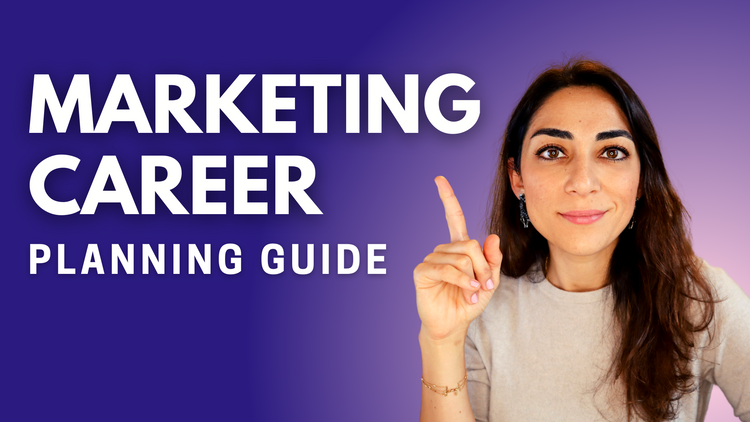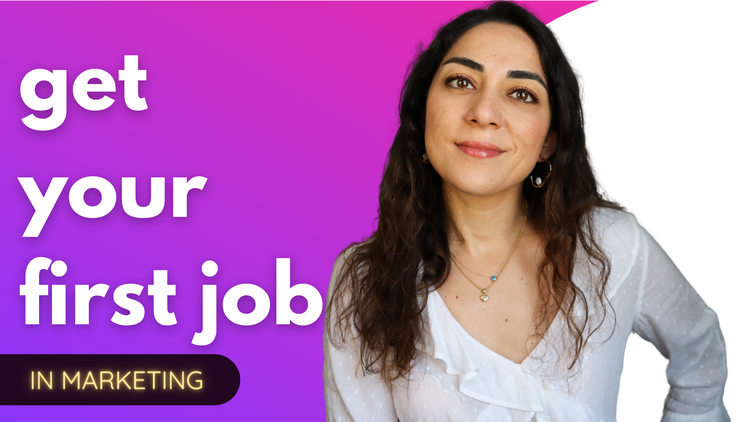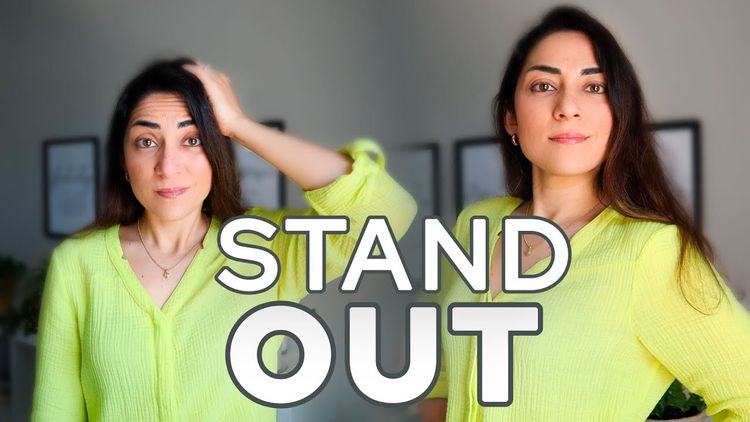Create a Marketing Learning Plan with 6 Simple Steps

There are so many learning resources and content out there on marketing, you might be asking
Where do I begin? How do I not overwhelm myself? How do I create a roadmap? What should the timeline look like?
The articles and videos listing the resources to learn marketing are a great place to start and I have a handful of posts and videos on this too, for example this blog on free marketing resources to follow. (I’ll list a few more at the end of the post so I don’t overwhelm you now!)
But when you have no idea where to start and come across an article listing 25 resources with thousands of pieces of content each – there’s no way you can consume all of it! Just like how a subscriber mentioned to me:
“The confusion I am facing now is that I have enough resources in my bag that would help me enhance my skills and knowledge regarding marketing, thanks to your videos but I don’t know how to organize it or from where should I start.”
So you may be like this subscriber, who wants to pursue a marketing career but is not sure where to begin with all the resources you have at hand, be it online courses, Youtube videos, blogs etc. there is just so much out there it feels overwhelming!
I get you!
And at the same time, you also want to be learning in a way that helps you reach your career goals and move you forward, and not just be merely consuming content.
Right, so where do we start?
First of all, I would approach it by creating a learning plan for marketing if you’re interested in learning more about this field – whether that means doing better marketing for your own business or if you want to pursue a marketing career.
By creating a roadmap for your learning, which I’ll walk you through 6 simple steps in the following, you’ll walk away with a customized and effective learning plan, giving you the clarity and guidance you need to tackle learning marketing!
Create a Marketing Learning Plan with 6 Simple Steps
What is Your Context for Learning?
Before we dive in, it is important to get clear on your context for learning. Whether you are a freelancer, job seeker, business owner or simply wanting to upskill in your marketing role, creating a learning plan is applicable for all as it will only help you learn faster and better in a more structured way.
Start by asking yourself a few simple questions to get clear on your context for learning, in simpler terms, what are you learning marketing for? What is the objective of learning marketing? Is it to help you land your first job? To help you grow your business? etc.

1. Assess and Visualize
Leading on from knowing your objective of learning, it’s best to start by assessing where you’re at and where you want to be. Be more specific about your objectives of learning marketing and map out what you already know and what you will need to get to your goals.
- Where do you currently stand?
- What are your goals?
- What do you currently know?
- What’s the vision for yourself? (What role would you like to be in?)
As you reflect on these questions, it’s important to continuously relate it back to your overall objective for learning marketing. Is it to help you land your first job, is it to help you get better at your marketing role, is it to learn marketing to grow your business?
Or maybe you just want to see if marketing is a field you would want to get into and it sparks your interest. But by identifying what your exact goal is with learning marketing, it will help you see where you are and the knowledge gap you need to fill in order to achieve that goal.
Essentially, it’s about using your WHY and interests as a starting point to guide you to the most relevant resources that you would need.

I would also suggest you to be as specific as you can with your interests. It could be a particular sector you are interested in e.g. sustainable clothing, sports, finance etc. make a note, and then also look at the specific branch of marketing you are interested in, e.g. social media marketing, SEO, or want to specialize in.
Marketing is so diverse and there are so many branches, and if you are still struggling and want more information about choosing a specialization, I’ve got a blog post here just for you.
Remember, every time you get overwhelmed, focus on getting specific with your goals, look at what you already know, and identify the knowledge gap you need to fill to achieve the goal. With that, you’ll be able to be strategic with your learning and time!
2. Designing Your Marketing Learning Plan
Once you gain some clarity to where you’re heading in the bigger picture, it’s time to design your learning plan and by zooming in on the specific skills and areas you are to fill in the gaps.

A couple of questions to get you started with:
- What skills am I looking to gain?
- Which part of marketing do I need to develop in particular to fulfil my ideal role and reach my career goals?
- What do I already know?
They might differ depending on which stage you’re at, if you are new to the field, you might want to start by looking into the different paths of marketing and educating yourself on that. For others, it may be looking at specific hard skills you need to develop, e.g. video content creation, learning about Facebook ads etc.
The idea is to pin down the specific skills you need to develop in order to get to your goal. A good place to start off is to list everything you already know about marketing, or is relevant to the area you are looking to develop. Be it the terminology you are familiar with, or a training or course you had, compile them all in a list. Maybe you already have a marketing degree and just lack the experience of doing, or working in a certain environment etc.
So for example, you might have taken a 6 week content marketing course and gained specific skills like creating a content marketing plan etc. just note them down and even rate them on a scale on your level of knowledge, and start practicing them, giving it another rating based on your actual practice of doing it.
Another common scenario which could be many of you here, is for example you are learning marketing with an ideal role in mind, or a company that you wish to work in, where you are already starting to apply for jobs. At this point, it will be good to pull up the job description of the ideal role, go through and highlight the specific skills they are looking for.
Ask yourself:
- Are you familiar with concepts or terminology used? (e.g. SEO, content marketing)
- Are you familiar with the technology the company uses? (e.g. Mailchimp, Yoast SEO, WordPress, Mailerlite)
- Is there anything else you need to have a deeper knowledge on? (e.g. You have a basic idea of buyer’s persona but want a more grounded knowledge)
- Any specific experience they’re looking for? How can you get this experience? Apprenticeship? Freelance work?
With this approach, you will be able to break down all your learning into very specific and targeted skills to develop in order to attain that particular role.
3. Choosing the Best Resources
Before you begin looking at the pile of resources you have, it’s important to make learning the most effective and optimal. Ask: What resources are most relevant for me and how do I learn best?

Look at Your Learning Styles
It’s sometimes neglected, but by considering your learning styles, you can identify the best resources for learning marketing. Some people learn best by reading, watching videos, individual work or self-studying, or some might prefer to learn in groups etc.
Identify the formats of content you prefer to consume and that can help you filter out a lot of the sources. If you don’t know your preferred learning style, I’ve got a handy resource here to help you identify your learning styles.
Next, it’s important to keep in mind the quality of the sources, ask: which resources are the most credible and how do I filter them? This is a tricky one, especially with so much content out there, you have to be selective, and sometimes you might have to look beyond the top ranking sources. A suggestion would be to follow a selection of thought leaders in the field and look at the content they are sharing, and see which ones you prefer, whether it is their delivery style or certain expertise, explore what works for you.
Learn by implementing
Some people learn best by doing and implementing. It doesn’t need to be complicated, and you can create your own projects or help with a friend’s blog or social media etc. to start applying your learning and knowledge. For some ideas, I have a video here sharing how easy it is to start your own marketing projects to gain the relevant skills and experience you need!
4. Grouping the Learning Areas

Now that you have your list of specific learning areas and skills, you just have to group them into categories so that you can focus on each area and learn them one by one, instead of scrambling between unrelated topics and losing your momentum. So for example, you might dedicate a certain area of your learning plan to technology and tools, so you focus on that and not overwhelm yourself with other areas. Once you get comfortable, you can move on to the next area and bit by bit, you can cover everything you need to learn for marketing!
5. Prioritize Your Items

Prioritizing is essential to any learning and do so by prioritizing each skill on your learning plan in order of importance in relation to the goals you set out at the beginning.
And sometimes the most important ones could be the most challenging and boring ones, but you need to work through them first as they could be most related and relevant to helping you progress towards your goals Keep them at the top of the list and this will help you stay on track, and you can move down to the others once you’ve tackled them.
6. Setting a Timeline

Next, look at your resources, topics to cover and set estimated times to complete. If you choose to take an online course or certification e.g. Hubspot, they might already come with a set timeline e.g. 4 weeks or specific hours.
Be sure to map out the start and finish dates for yourself so you can work out when you move on to the next learning area. Also think about the specific time you can commit and allocate to learning, be it per day, week or even for a year.
For example, I always allocate a certain number of hours per week for learning and that includes could include practicing a skill, learning something new, but make sure you note it down in the plan how much time you estimate to learn a certain skill, how much time you can allocate to each area of the plan to help you stay accountable and consistent with learning.
Final Thoughts
Armed with these 6 simple steps, you’ve now built a roadmap for your own marketing learning. As you work through the steps, you will find more clarity, and develop actionable steps to help you progress towards your goals with a broad vision connected to your career path or personal goals.
As promised, here I’ll list the relevant resources on learning marketing, especially now that you have taken into account your learning styles and objectives, you’ll be able to sieve through and compile quality resources that are most suitable for your learning!
3 Ways I Can Help You When You're Ready
1. Be a better marketer with the resources I created, including a kickass course to help you land your dream marketing job, templates and lists of resources to accelerate your learning.
2. Work 1:1 with me to define your career roadmap and get support for your marketing job application process.
3. Get in touch to join Superside, Integromat, Whatagraph and many others to promote your brand or business through partnered content on YouTube and other social media platforms to an audience of self-learner marketers!





![How to Prepare for a Marketing Interview [Questions + Answers]](/content/images/size/w750/wordpress/2021/07/Elif_MarketingInterviewQuestions.png)